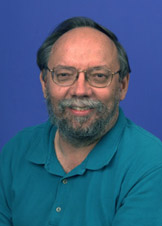Dr. Joseph D. Miller
The article Methane-Producing Bacteria Bolster Claim of Life on Mars said
“Evidence of methane-producing organisms can be found in inhospitable soil environments much like those found on the surface of Mars, according to experiments undertaken by scientists and students from the Keck School of Medicine and the University of Arkansas…‘Methane-producing organisms are the ones most likely to be found on Mars’, said Joseph Miller, associate professor of cell and neurobiology at the Keck School and one of the study’s lead researchers. ‘And, in fact, methane was detected on Mars earlier this year.’
Joe has previously analyzed evidence from the Viking Lander missions and found that soil samples taken in the 1970s from the Martian surface exhibited a circadian rhythm in what appeared to be nutrient metabolism, much like that present in terrestrial microbes.”
Dr. Joseph D. Miller is Director of Pharmacology and Associate Professor of Research, Department of Cell and Neurobiology, at the Keck School of Medicine at USC. He received his B.A. in Psychology and Biology from Yale University in 1971 and his Ph.D. in Physiological Psychology (Neuroscience) from the University of Texas at Austin in 1979.
His research utilizes behavioral, cellular and molecular approaches to the study of sleep and circadian rhythms. He does behavioral, electrophysiological and neuropharmacological studies of neurons in the anatomical locus of the biological clock in mammals, the suprachiasmatic nucleus (SCN) of the hypothalamus. He examines the effects of such agents as serotonin, nicotine and dioxin on circadian behavioral rhythms in vivo and circadian neuronal rhythms in vitro.
The basic question he is interested in is how the SCN generates a synchronized neuronal rhythm. This requires an understanding of the molecular machinery of the SCN at the single cell level, as well as an understanding of the intercellular mechanism that produces synchronization of the neuronal population. In collaboration with Dr. W. Dayawansa of Texas Tech, he is simulating the activity of 16,000 SCN neurons on a supercomputer to explore the details of intercellular synchronization. In other projects he is examining the degeneration of circadian rhythms in an animal model of Alzheimer’s, as well as the persistence of high amplitude rhythms in an animal model of antidepressant therapy. Finally, he is heavily involved in stem cell research, in particular the application of stem-cell derived dopamine cells in Parkinson’s disease.
Joe coauthored How To Develop The Solar System and Beyond: A Roadmap to Interstellar Space, Developmental changes in nicotinic receptor mRNAs and responses to nicotine in the suprachiasmatic nucleus and other brain regions in Molecular Brain Research, The glutamate-induced phase shift of the circadian rhythm in single unit activity in the SCN slice: a two pulse study in Brain Research, and Behavioral and Serotonergic Regulation of Circadian Rhythms inBiological Rhythm Research.
Read his LinkedIn profile.
